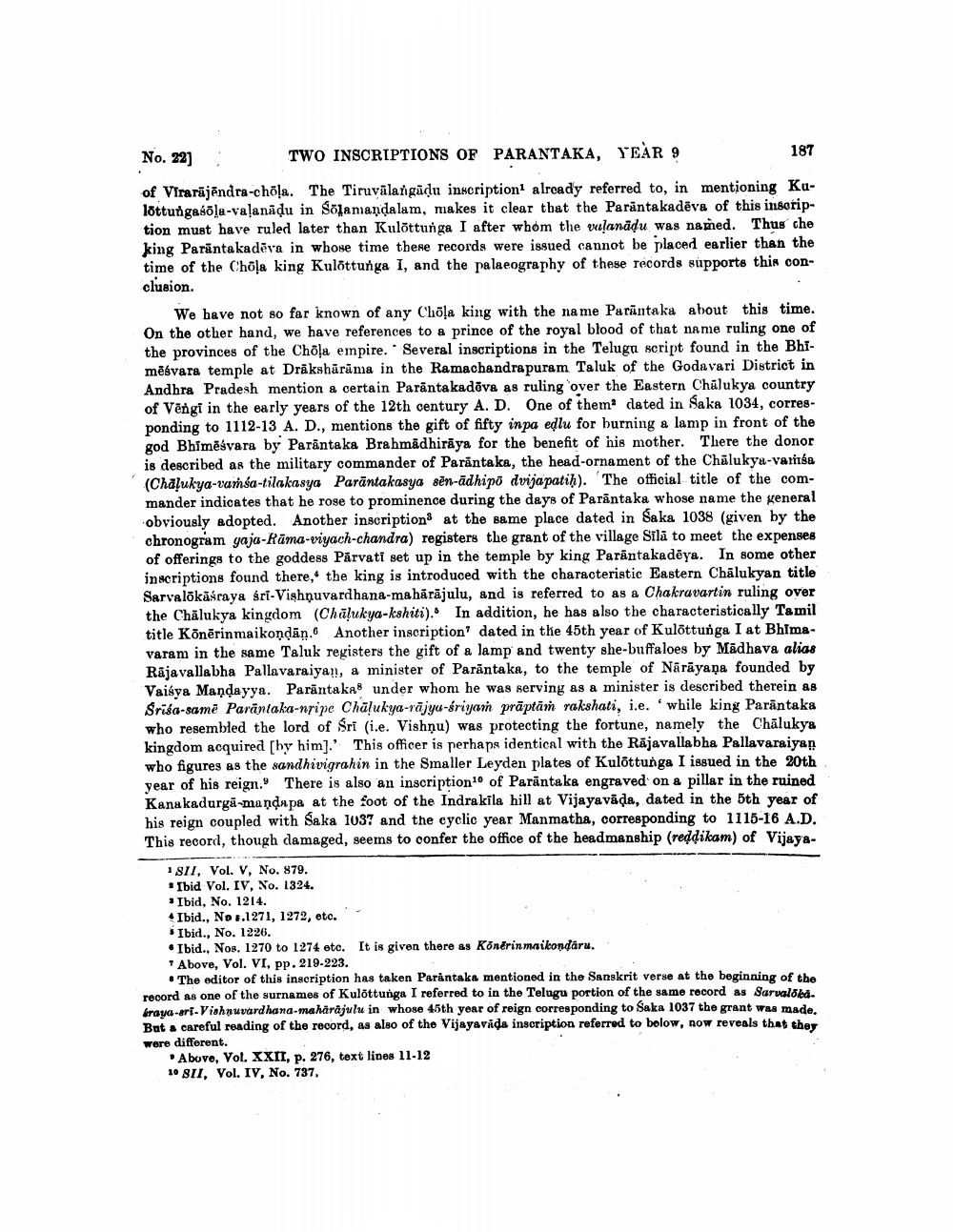________________
187
No. 22]
TWO INSCRIPTIONS OF PARANTAKA, YEAR 9
of Virarajendra-chōla. The Tiruvalangaḍu inscription1 already referred to, in mentioning Kulöttungasola-valanadu in Solamandalam, makes it clear that the Parantakadeva of this inscription must have ruled later than Kulottunga I after whom the vulanadu was named. Thus che king Parantakadeva in whose time these records were issued cannot be placed earlier than the time of the Chōla king Kulottunga I, and the palaeography of these records supports this conclusion.
We have not so far known of any Chola king with the name Parantaka about this time. On the other hand, we have references to a prince of the royal blood of that name ruling one of the provinces of the Chola empire. Several inscriptions in the Telugu script found in the Bhimēsvara temple at Draksharama in the Ramachandrapuram Taluk of the Godavari District in Andhra Pradesh mention a certain Parantakadova as ruling over the Eastern Chalukya country of Vengi in the early years of the 12th century A. D. One of them dated in Saka 1034, corresponding to 1112-13 A. D., mentions the gift of fifty inpa edlu for burning a lamp in front of the god Bhiměśvara by Parantaka Brahmadhiraya for the benefit of his mother. There the donor is described as the military commander of Parantaka, the head-ornament of the Chalukya-vamsa (Chalukya-vamsa-tilakasya Parantakasya sen-adhipo dvijapatiḥ). The official title of the commander indicates that he rose to prominence during the days of Parantaka whose name the general obviously adopted. Another inscription at the same place dated in Saka 1038 (given by the chronogram gaja-Rama-viyach-chandra) registers the grant of the village Sila to meet the expenses of offerings to the goddess Parvati set up in the temple by king Parantakadēya. In some other inscriptions found there, the king is introduced with the characteristic Eastern Chalukyan title Sarvalōkāśraya śri-Vishnuvardhana-mahārājulu, and is referred to as a Chakravartin ruling over the Chalukya kingdom (Chalukya-kshiti). In addition, he has also the characteristically Tamil title Kōnērinmaikoṇḍān. Another inscription" dated in the 45th year of Kulottunga I at Bhimavaram in the same Taluk registers the gift of a lamp and twenty she-buffaloes by Madhava alias Rajavallabha Pallavaraiyan, a minister of Parantaka, to the temple of Nārāyaṇa founded by Vaisya Manḍayya. Parantakas under whom he was serving as a minister is described therein as Srisa-same Parantaka-nripe Chalukya-rajya-śriyam präptām rakshati, i.e. while king Parantaka who resembled the lord of Sri (i.e. Vishnu) was protecting the fortune, namely the Chalukya kingdom acquired [by him]. This officer is perhaps identical with the Rajavallabha Pallavaraiyan who figures as the sandhivigrahin in the Smaller Leyden plates of Kulottunga I issued in the 20th year of his reign." There is also an inscription10 of Parantaka engraved on a pillar in the ruined Kanakadurga-mandapa at the foot of the Indrakila hill at Vijayavada, dated in the 5th year of his reign coupled with Saka 1037 and the cyclic year Manmatha, corresponding to 1115-16 A.D. This record, though damaged, seems to confer the office of the headmanship (reddikam) of Vijaya
18II, Vol. V, No. 879.
2 Ibid Vol. IV, No. 1324.
Ibid, No. 1214.
4 Ibid., No.1271, 1272, etc.
Ibid., No. 1226.
Ibid., Nos. 1270 to 1274 etc. It is given there as Könerinmaikondāru.
7 Above, Vol. VI, pp. 219-223.
The editor of this inscription has taken Parantaka mentioned in the Sanskrit verse at the beginning of the record as one of the surnames of Kulöttunga I referred to in the Telugu portion of the same record as Sarvalōkā. braya-sri-Vishnuvardhana-maharajulu in whose 45th year of reign corresponding to Saka 1037 the grant was made. But a careful reading of the record, as also of the Vijayavida inscription referred to below, now reveals that they
were different.
Above, Vol. XXII, p. 276, text lines 11-12
10 BII, Vol. IV, No. 737.




